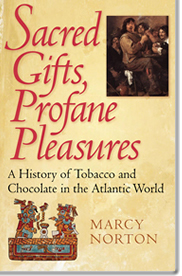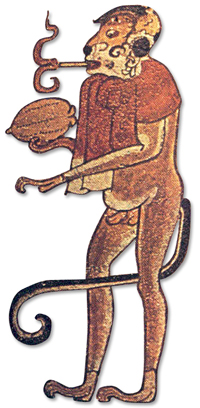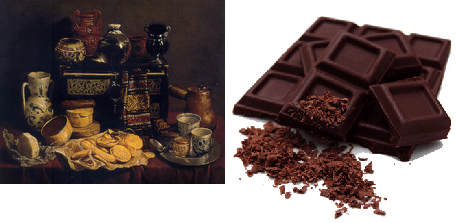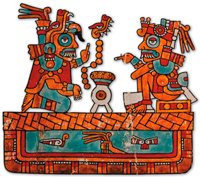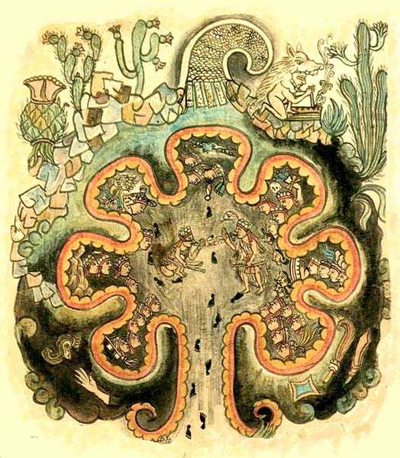Get it on Amazon Sacred Gifts, Profane Pleasures (“SGPP”) – a title that resounds as an answer back at RC Zaehner’s Mysticism, Sacred & Profane (1961) & whose subtitle faintly echoes Tomas Hurtados’ Chocolate y Tobaco Ayuno Eclesiastico y Natural (1645) – begins & ends with that 2-letter word in the middle of ‘life’. Lest anyone think that all the pages in between are also a bit ‘iffy’, this is an important work. Much like Darwinian evolution, gaps appear in the storyline yet the overall arc of this history connects the dots.
The central questions driving this book for 250+ pages shape up as, why did it take over 100 years for Europeans to embrace these two substances prized by, & identified with, Amerindians? And how did that acceptance, which entailed habit-forming addictions, eventually come to supplant coveted spices from Asia, as well as the laurel extolled from antiquity, & even the olive branch of the Bible — all part of a move that saw the Western hemisphere trump the East as the world’s primary source of pharmacopoeia?
The long & short of it: first, Diachronic – thru making the strange & exotic the familiar & desirable; & second, Synchronic – an extended set of dynamics – subliminal & ideological – underlying cultural transmission, or memes, flying back & forth across the Atlantic.
Author Marcy Norton focuses on that crucial moment in human affairs when two civilizations met – known as The Contact Period – as the Old & the New Worlds, represented by Spain & Mesoamerica, embraced to trigger the Columbian Exchange that would accelerate globalism. She plumbs the very depths of the archives for original source material. Half the book feels weighted by footnotes (one of which racks up a mini-library’s worth of titles) with the lurking-danger that SGPP may simply be exhaling & regurgitating what has already been smoked & ingested elsewhere; a re-telling, of sorts, from several primary sources compressed into a Cliff-Notes version.
So, one could ask, why undertake her pharmikon argosy? For starters, Norton steers clear of the many modern myths surrounding tobacco & chocolate (e.g., Motecuhzoma gulping 50 goblets a night prior to entering the harem for his work grind) which have made it into the standard pop accounts. More tellingly, she drafts a parallax outlook on the conventional narratives by drawing from the periphery to the center. Above all, SGPP builds on the work of others, as does for example the Coes’ True History of Chocolate which cribs from When Money Grew on Trees by René Millon, but much of what’s written here is based on sources no one has considered before.
For any who doubt a connection between chocolate & tobacco, note ‘Exhibit A’ that it was customary protocol for the Mexìcâ (Aztec) court to welcome dignitaries with royal fanfare; that meant a goblet of cacáo for stimulating good mood & conversation with tobacco tubes for their relaxing effects & sign of friendship.
Or the iconography in Exhibit ‘B’ – this randy monkey-man on a Late Classic Maya vessel:
Smokin’ Monkey Man – Drinking vessel (detail); Late Classic Maya (600-750 CE). Monkeys are the great purveyors of cacáo seeds in the jungle & Mesoamericans associated them with creativity & art. This shows the chocolate / tobacco connection (cacáo pod held in his right hand) by the Maya, later extended by the Mexìcâ, plus the excitement of it all (tail between his legs).
Exhibit ‘C’: the scholastic kinship between SGPP & Bartolomé Marradón’s publication in 1618 of Diálogo del uso tabaco, los daños que cause y de chocolate (Dialogue on the Use of Tobacco & Chocolate & the Harms They Cause).
Since then both chocolate & tobacco have become ever-loving habits (for good & ill). The bonds seem to be enduring.
But their rise to global commodities took divergent paths.
Tobacco was equated with devil’s smoke & transgressive lowlife ruining their lungs, whether inflamed by fumes or excited by snuff, while cacáo was drunk as the champagne of fallen angels from paradise lost. Both inevitably were accepted, artificial cravings be damned, by Europeans, though not without a struggle. One was “forbidden under the penalty of eternal damnation” by a 1583 Spanish ruling in Lima (Peru); the other was considered the “scumlike” foam that resembled feces written about by Jesuit José de Acosta seven years later in Historia natural y moral de las Indias. One passed quickly as an aristocratic’s prized ‘delicia’, introduced to Europe by wealthy merchants as of so much manna from heaven to be regaled in still-life paintings, & rather private too, belonging to the domestic space of the household that only eventually & gradually trickled out to the masses. The other democratic & more a public mania that had a much harder climb up the social ranks before it found itself among nobility, coming hellishly from the bottom up, brought over by low-wage mariners, the stuff of snuff that meant snot-to-shit with sex in-between, taken in social taverns where the twain nevertheless met around continental Europe.
Their eventual rise returns to our central question & its most succinct answer being one of simple supply & demand.
On the supply side, cacáo, already commodified prior to Columbus, enjoyed an imperial infrastructure during the reign of the Mexìcâ (Aztecs) for its production & distribution that logistically fit right into Transatlantic trade. Whereas tobacco was grown on discrete or at best loose-knit farms on the periphery of the Eastern Caribbean, by & large impoverished islands (once the Europeans extracted all the gold & pearls from them), far from any major political center, it had to be aggregated or rolled-up for Transatlantic trafficking. For the Spanish, that entailed conflicts with native Carib Kalima & Arawak Lokono who controlled much of the export tobacco on the ground, as well as dealing with European navies (Dutch, English & French) that rivaled Spain on the high seas.
On the demand side, Norton offers the circular logic that their market take-off was delayed because no mass market was waiting for them.
“The importance of communities of consumers – rather than solitary consumers – helps to explain why a Spanish market for tobacco & chocolate did not exist before the late 16th century…”
That this passes for scholarship rather than the obvious (a market is defined as more than one individual unless, of course, we’re talking about a market of one!) might be a cause of why Johnny won’t read anymore. What commodity from chocolate to fads like Teletubbies doesn’t require a mass market? Any popular explosion from Beatlemania to Miley Cyrus needs to be primed first like an undercoat of paint.
The interesting question is how & why it becomes one.
Norton discounts, & at times dispels, the effect Europeans had on improving chocolate thru various engineering feats that propelled it into a global phenomenon, holding fast to a romance that Europeans simply borrowed chocolate & blindly imitated Amerindians whose version of it nonetheless was reportedly unpalatable to Westerners.
The book recounts shipping logs & tax tables for cacáo & tobacco during a transitional period between 1590 to 1610. Trade in both items started to increase, as if their rise in the Old World took place in a sealed vacuum without the simultaneous jump in sugar cane consumption which Europeans were planting as the cash crop all around the equator during their colonizing venture. Lost on her is the ease with which sugar made its preparation, as well as creating a cleaner, more transparent pure play chocolate flavor. To claim that Europeans merely substituted sugar (which they did at the ratio of about 2 parts cocoa to 1 part sugar or more) for the honey in the beverage of Mesoamericans is problematic. (We’ll possibly never know the true taste of ancient cocoa. Some accounts put it at quite bitter – with one Santiago Valverde Turices acknowledging that a drink stained red with achiote was necessary for brighter color & better flavor. Then again, considering the mild Criollo strains naturally selected & harvested by Mesoamericans, this evaluation may be relative.) Even allowing for honey’s greater sweetness factor, at their equivalent sweetness one would no longer have a beverage but a syrup or, in the example of atole (chocolate mixed with corn), a thick gruel. Historical records show that Europeans dropped atoles rather early on & swapped out other native ingredients for reasons of taste preference in addition to convenience.
Nor does Norton provide convincing data on the dramatic shift in consumption patterns (she lists average per capita consumption in Spain circa 1610 at a dumbfounding 45 lbs., roughly double that of the leading country in the world today – Switzerland!) for if what Norton declares is true – that all we know of cocoa is a mere copy of Mesoamerican traditions – then how did cacáo & its derivative chocolate fall from grace as a sacred tree & stout draft to end up in the candy bin of every grocer, convenient mart, & drug store?
The answer has much to do with Coenraad Johannes Van Houten’s patents & processing of cocoa beans that led to a cascade of refinements to eventually create the flowering of chocolate as we know it – in the form of the chocolate bar. Adding back cacáo butter constitutes one such improvement for butter both fixes & carries flavor through the length of a bar’s progression &, given its melting qualities, prolongs the duration of the taste experience. Where a bar involves ‘break, bite, & bide’, a beverage, which is how Mesoamericans took their chocolate, is by contrast meant to be sipped then quickly swallowed if hot (only rare breeds slosh hot liquids around in their mouths). Cold drinks, on the other hand, put a deadening chill on flavor in much the way that so-called “raw chocolate” does in our contemporary era. Presupposing that they may have served it in between the extremes, such as at room temperature, renders a lukewarm compromise & result.
As seductive as the foam atop hot cocoa may be, it’s evanescent compared to the full sensory overload of cacáo’s butter delivery system. Coupled with the bar’s portability & durability, it can be argued that that gap between chocolate in the 17th century versus the 21st is widening for the better with the exception – & no small caveat – of genetic cacáo types being superior in the past.
Copycat design or the sign of progress in decline? An elaborate 17th century Chocolate Service (left) by Antonia de Pereda versus the modern bar (right).
***************************************
Complicating matters further are the overwrought, marginalist frames of Post-structuralism in this book. They obscure if not thwart Norton’s great research & sterling points.
For example, is ideological bigotry really the reason for the Spaniards “initial resistance to the alien substance” we now call chocolate? Precaution would seem to be a given in this situation. The conquistadores were on the other side of an unknown world, in a land none of them or their kind had ever ventured before. What does one expect when over half of the natural botanicals that look appetizing are in fact poisonous? How many hikers today carry GPS & snacks with them into the wilderness where foraging would sate their hunger except for ignorance? Consider with TV, iPhones, & the internet how long it takes, say, açai to catch on & penetrate the market, even after the likes of an Oprah endorsement!
Or Norton’s discussion about the lens thru which Columbus viewed Amerindians has as much to do with our own filters as his, & veer into psychoanalytic territory with perfect hindsight passing judgment on a culture half a millennium ago & thousands of miles away.
The book continues on… with habitual use of Spanish ‘imperial centers’, ignoring that native imperialism preceded it.
Orthodoxy comes to pervade these pages with the usual post-structuralist categories flying around (racism, sexism, Eurocentrism, hegemony, subjugation, domination, appropriation, homogeneity &, of course, the big bad bogey-man of all – “The Other” – ghosting over every chapter) which are pandemic nowadays that they’ve become inquisitional dogma. Even in tangential areas, for instance: the Spanish “usurpation of the Muslim Kingdom of Grenada”. It must follow then that Iraqis would be “usurping” America’s hold in Baghdad when the day comes for the U.S. military to leave there.
Instead of acknowledging mutual conflict, Norton seems to side with the native nobles (‘good li’l Indians’ to Karl von den Steinen’s “nature folk” in his 1894 book Unter den Naturvölken Zentral Brasiliens or James Cameron’s Na’vi in Avatar) in their eco-Eden, striving mightily to downplay internal divisions between, say, the Caribs & Arawaks, while managing to make the Euros primarily culpable. Considering who were the hosts & who were the visitors, she’s right though no less pharisaic for it. Spanish dominion indeed has a dark side; sadly, so too in many respects the indigenes they came to dominate.
Once past discourse, the modes of cultural transmission with respect to tobacco & chocolate are equally vexed.
Two men – Nicolás Monardes & Francisco Hernández – formed a bridge across the Atlantic over which cacáo & tobacco were diffused into Europe. Using the frameworks of Galen’s 4 essential properties (hot, cold, wet, dry) / humoral system (blood, yellow bile, black bile, phlegm), & Dioscorides’ De Materia Medica, they classified tobacco as hot & dry in the 2nd degree with cacáo being more neutrally cool & wet. This resulted in Europe embracing both by transforming them from tools of a barbarous alien culture steeped in ‘pagan idolatry’ into what fit a ‘civilized’ medical apothecary.
Norton seemingly undermines her own thesis; first, by arguing as if influences traveled only one-way. These medical classifications were wholly derived, she writes, from the Amerindians: “most everything Monardes & Hernández “understood” about tobacco & chocolate derived from a Mesoamerican system of taste & medicine… direct experience that was itself predicated on exposure to Mesoamerican cultural practices”. The greater likelihood is that Monardes & Hernández both borrowed AND deduced from the New World in conjunction with their own experience / experiments. Contradictions be damned, after 128 pages, Norton admits as much: “The process of incorporation was dialectical rather than one-sided.” Secondly, she writes on page 142, then repeated on Page 167 that they were recreational before they became medicinal which goes against her train of thought that Monardes & Hernández paved the way for their entrance into Europe thru medical filters.
What is called for here is more of a feedback model to explore the transformative nature of these interactions. Of course there were crosscurrents between Amerindian & Spanish cultures except for those who buried their heads in the sand thinking the Atlantic Ocean were some cultural moat. Miscegenation was a thing of the past, as in widely practiced & how the world conceived mestizo. Datasets support that collusion more than conflict explains why so few Spanish, who comprised only a tiny fraction of the population in the New World for centuries after their arrival, yet exerted tremendous influence to largely substantiate Fernández-Armesto’s “stranger effect” over the conventional wisdom that guns & germs made the Spaniards victorious.
*****************************
That aside, Chapter 8 – Consuming Rituals – contains key symbolic associations of chocolate’s (& tobacco’s) past in the West that may help restore its status as, if no longer royal or sacred, at least a delicacy instead of a cheap luxury. It infers 2 issues: a) how to decommodify a commodity in a market currently shaped by high volume / low price (perhaps the transformation that wine took in the USA during the 1970s/80s could be instructive here); & b) how to increase chocolate’s commensality. As is, especially in bar form, chocolate is not so much exclusively but somewhat a private affair often reserved for solitary settings, epitomized by Jean Harlow hoarding it to fill the void & feed loneliness in Dinner at 8. Or the sly quip that defines discipline as the ability to break open a bar & share it. Quite a divergence from the Baroque period in Europe when it was the center of parties & public celebrations, albeit as a draft or beverage.
Among the high points of the entire book, Norton takes readers on a superb exegesis of La Xocolatada (pictured above), a tiled painting once part of the courtyard wall belonging to the estate of Marqués de Castelvell where special chocolate drawing quarters (pieza de chocolate) were appointed in the grand residence. Now housed in the Museu de Ceràmica Barcelona, a detail of La Xocolatada graces the cover of the Coes’ True History of Chocolate. In the manner of a virtual museum guide or curator, she tours around the party & revives the scene for us that places the chocolate service right in the middle, at the center of hospitality, in a ritualized setting. Juxtaposed with flowers, rich paintings, crystal trifles & every sort of opulent marker linked to social bonds, convivial cacáo surpasses all including gossiping, flirting, feasting & even dancing… seeing how everyone’s center of attention is cast toward it, eager to have some. It recalls the now-ancient Mesoamerican banquets hosted by Mexìcâ long-distance merchants (the pochteca) to honor warriors & nobles fueled by cacáo, celebrating intimacy of an erotic nature, the medium for love potions, spurring libidinal urges. As someone in attendance put it – when a party lacks chocolate, it’s not a party. Or Antonio Hurtado de Mendoza’s ‘Couplets of Chocolate’ (punning off a ‘cup of chocolate’) writing about this scarlet extravagance & embraces at the boiling point culminating in bites of the appetite while breasts are heaving as every dream is indulged considering that “the definition of love is chocolate.” Coming full circle, La Xocolatada draws a quick glance back to the Mixtec couple married in the Codex Vindobonensis Mexicanus in chocolate.
Of cacáo’s many challenges, these 2 aspects – escaping the cheap commodity markets& elevating its social status from where it presently functions as a candy bar, a food bar, or a flavoring – would go some distance to cure its sore state so that cacáo, once literally sacred & noble, then mass-produced & impoverished, regains its former glory.
Another significant chapter – Monopolizing Vice – contains the early rationale for taxing non-essential luxuries that our own political class today uses to feed illimitable appetites for pet projects, levying “sin taxes” on everything from cigarettes, liquor, travel & soon soda because they cynically calculate, as the Spanish Crown did in the 17th Century, “that those partial to the vices had a dependency such that mere price increases would not deter their passion, & hence not risk sabotaging the economic success of the tax…” So once classified as a vice, the State sanctioned them & became the guarantor of their provision as any pusher to a junkie.
Cocoa / tobacco “vice” gets woven into a riveting drama on the crypto-Jews, some of whom successfully bid for the royal warrants as purveyors of these monopolized goods during the Inquisition. Narrated thru the life story of Diego Gómez de Salazar, Norton tells of the hurdles he surmounted to obtain the monopoly, describing the labyrinthine commercial network down to minute details, as well as his clandestine attempt to remain faithful to “St. Moses”. For Gómez, it netted wealth but also incarceration at the behest of the Inquisition, then eventual escape to a safe-haven for conversos & Marranos in Bayonne, France to establish a budding Jewish chocolate scene that thrives to this day. Others headed farther north to Flanders where they became chocolate specialists in Amsterdam. And in a side bar, most of the traveling chocolatiers going door-to-door, freshly grinding cocoa beans with metates in southern France throughout the 19th century, were Sephardics.
Monopolizing vice returned a double dividend for the Crown. It brought wealth into its Treasury &, moreover, supplied the building blocks for the rise of centralization & increased power of the State that would have lasting effects.
Additionally, it shifted the cultural value of tobacco & chocolate, from a medicine in the Monardes & Hernández scheme into an everyday luxury.
No less than a startling grand thesis emerges by the end of SGPP: tobacco & chocolate have conspired in the development of the State in Spain & simultaneously undermined the authority of the Church. In the process they’ve “helped to usher in a phase of modern consumption in which sublime attention was displaced from religious activities to secular” ones…. a combined theobromine-nicotine dream, of sorts, complete with cosmic envisioning & somatic payback.
Did these payloads, as much as Luther, subvert the Church’s omnipotence & monopoly on cosmological truth? Were they more sacrilegious than breaking vows of celibacy?
Plus, even more startling, they sabotaged the victors? Here’s the theory:
This intrigue exposes Amerindian medicine with now-counterintuitive impressions of tobacco, quoting how a Spaniard in the Yucatán learned that “smoke is beneficial for phlegmatics, asthmatics, & chest coughs.” It forms part of wider native strategy of resistance against Europeans, of natives having the Creoles, as do tales & fables of these potions casting spells ranging from expelling worms to falling in love.
Monardes likewise picks up on this, outlining 20 or so curative properties of tobacco ranging from alleviating asthma, relieving parasites & calming epilepsy. A veritable panacea despite the warning of Dr. Juan de Cárdenas, a Spaniard educated in Mexico & author of Problemas y secretos maravillosos da las Indias (Problems & Marvelous Secrets of the Indies) published in 1591: “use it well for without order or measure or discretion it is dangerous, pernicious, & pestilential”.
A 1629 satirical play by Francisco de Quevedo titled Discurso de Todo Los Diablos (Talk Among Demons) implicates tobacco & chocolate in an underhanded tale of revenge that may nonetheless be on the money:
“There came the devil of tobacco & the devil of chocolate, who, despite my suspicions, told me they were not the cause of all evil… They told me they had avenged the Indies against Spain, for they had done more harm by introducing among us those powders & smoke & chocolate than the Catholic King had ever done thru Columbus & Cortés & Almagro & Pizarro. For it was much better & cleaner & more honorable to be killed by a musket ball or a lance than by snuffling & sneezing & belching & dizziness & fever; the chocolate-bibbers idolize the cup that they raise on high & adore & go into a trance over; tobacco consumers are like Lutherans [heretics]: taking it in smoke, they are serving their apprenticeship for hell”.
Norton herself takes up the thread: Avenging the destruction wrought by conquistadores in the Americas, these substances of New World provenance subjected Euros to their rule. Enthralled aficionados now behave like religious devotees, such that chocoholics treat it like wine consecrated during Mass & smokers risk damnation. This sacrilege connects the compulsive adoration of the acolytes back to their origins among Amerindian “idolaters”.
Cancer rates among smokers, & chocolate addiction, represents the price that has been exacted.
These noxious outcomes bear reminders of the forebodings (perhaps apocryphal), supposedly told in another book, of Fray Diego Duran, by the Mesoamerican goddess Coatlicue (“Serpent Skirt”) in the Virtue on the Hill called Culhuacan (Nahua for “place of those with ancestors”; in Azteca codices, the symbol or glyph representing the toponym took the form of a ‘bent’ or ‘curved’ hill – a play on the homonym col- in Nahuatl, meaning bent/twisted by old age) when she cautioned how chocolate can make one heavy, tired, weak, old & ultimately hasten death.
Or could this all be just a rationale on the part of natives for losing the New World?
The 7 Caves at Chicomoztoc – a mythical land from where the Mexìcâ (Aztecs) claim their origins. The ‘curved hill’ at the top depicts Culhuacan.
**********************
Emigrés returning to Europe from the Americas were once called Indianos, opening a rift in the Spanish world between Iberians in the homeland & Creoles across the Atlantic, over their differing views about these two goods. Despite anti-smoking campaigns, tobacco permeates right up thru to today, & chocolate continues to spread its subtle Amerindian influence around the globe. Both are more than mere botanicals. They represent primordial & social history. Today neither instantiate Satan in tobacco’s case or godhead in chocolate’s when it was a gift from a divine source & proof of divinity itself. Their long journeys have made the extraordinary into the rather ordinary, their magic migrating into enchantment. No longer the ‘food of the gods’, they’ve become the fuel for modern consumer fantasies burnt right into the bloodstream.
Thanks to Marcy Norton for elucidating that they’re so native to this American hemisphere, & elsewhere, that we are all Indianos now.
READING QUIZ
One can deduce from Prof. Norton’s research that:
a) European settlers to the New World were helpless babes in the woods until natives & later Africans saved them;
b) Columbus hit his intended target – the spice route to India – because, after all, the people he met here are called Indians;
c) Motecuhzoma reportedly gulped 50 goblets a night prior to entering the harem for his daily grind where he spent less time in the bedroom & more time in the bathroom;
d) chocolate comes from outer space as evidenced by iconography on King Pakal’s sarcophagus lid at Palenque which depict him as a cacáo-carrying ancient astronaut from the future;
e) we are all in a sense Indios now due to the global addiction of 2 substances from the Americas—tobacco & chocolate
